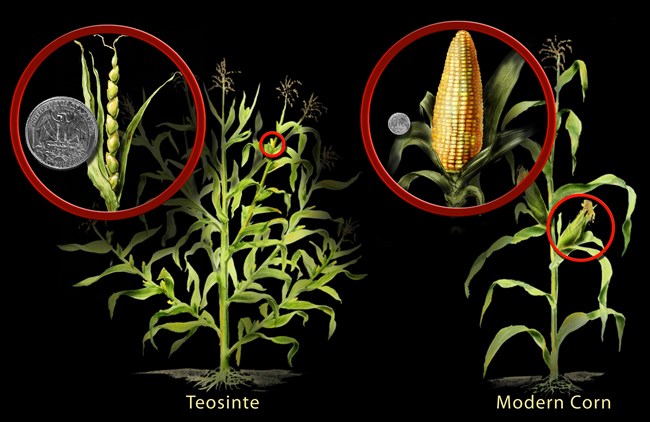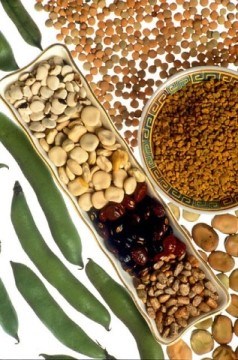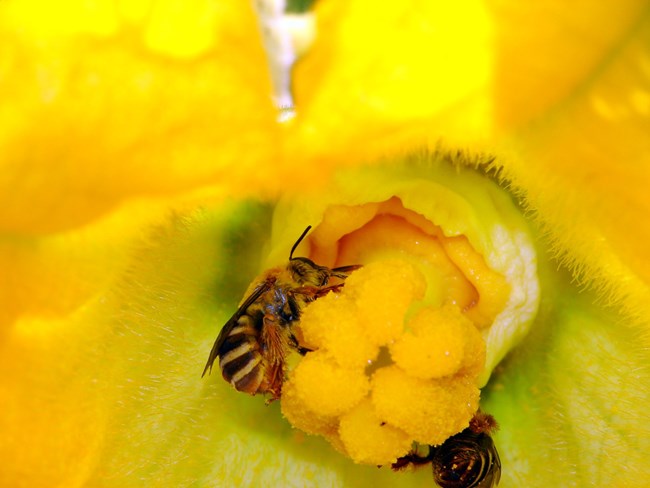
Image by Lopez-Ridaura, S., Barba-Escoto, L., Reyna-Ramirez, C. A., Sum, C., Palacios-Rojas, N., & Gerard, B. is used under the Creative Commons Attribution 4.0 International License (CC BY 4.0). Companion PlantingThe Three Sisters planting method, commonly known as companion planting, entails growing corn, beans, and squash together in a mutually beneficial arrangement. It originated in North America around 3000 years ago.In the absence of readily available grains such as wheat, and without the presence of pack animals, this technique enabled people to thrive in harsh environments while maintaining a nutritious diet. Ancient civilizations discovered that these crops flourished when planted in close proximity. These three plants work better together than when grown alone, creating a self-sustaining ecosystem that nourishes the soil and produces abundant yields. Each plant brings unique advantages to the others; Corn serves as a trellis, providing a framework for the beans to grow and wrap around. Beans, acting as a natural fertilizer, add nitrogen to the soil, which benefits the growth of the corn and squash. Squash is typically planted between the corn and beans, and its ample leaves serve as a shield, blocking heat, retaining soil moisture and suppressing weed growth. Many other plants can be grown together in your own garden. For example, dill and basil would protect tomatoes from being invaded by hornworms without competing for nutrients in the soil. CornCorn, also known as maize, is a versatile and widely consumed crop that has a long and fascinating history. Its origins date back to between 9,000 and 10,000 years ago when it was used infrequently by the Natives of Mexico. At this time, a species of grass called teosinte was the precursor to modern corn. The Native Americans of Mesoamerica chewed the sweet stalks of teosinte, like the agave plant, while ignoring the seed pods that were covered in a tough outer shell and therefore inedible. By utilizing selective breeding, which is the act of choosing and planting genetically mutated seeds, corn evolved from teosinte. Presently, the four wild versions of teosinte are either threatened or endangered.After considerable selections, the hard outer shell of teosinte stopped growing, and it turned into what we now know as maize. The plants were likely fertilized with the byproducts of fishing along with other nutrient-rich compost. This process led to the creation of many varieties of corn over the next 1,000 years, which continued to change over time. One of the earliest uses of corn was for grinding into cornmeal and flour. Some of the first varieties of maize were incredibly hard and were ground using a mano y metate, a grinding tool that had been used by many people for millennia. The mano is a rock that one would hold in either one or two hands, and would ultimately become smooth as it ground corn in the metate, a concave stone slab. 
Photo by Nicolle Rager Fuller, National Science Foundation Despite its versatility, maize is not high in calcium, niacin, or protein. To enhance its nutritional value, the Native Americans developed a process called nixtamalization. This process involves boiling the corn in water with wood ashes or crushed limestone. The alkaline calcium hydroxide, which contains about 33% calcium, softens the kernels enough to peel the hard outer shell called the pericarp while adding nutritional value to the plant. Nixtamalization is a necessary process when creating masa, or cornmeal dough, that is used to make corn tamales (and eventually tortillas). It is believed that the first type of this dough originated in 1,000 BCE. This process was also used with the flour type corn to develop hominy. The niacin provided by this process prevented an illness called pellagra. Other uses of corn during this time included cornbread, corn pudding, corn soup, and fried corn cakes. A modern example of corn usage by the Native Americans is a traditional bread called piki bread. It is made using blue corn that is ground on a metate then mixed with the ashes of a juniper tree, then cooked on a large flat stone using the oil from squash seeds. When Columbus arrived in 1492, he found the natives using corn and brought the plant with him on his return. Corn was then introduced to Europe, starting with Spain. It wasn't until the 16th century that corn spread across Europe as a popular and regularly used food product. By the 18th century, it had found its way into Africa, Asia, the Mediterranean islands, and Australia. Corn has since become a staple crop as the 3rd most grown crop in the world, and 1st in the US. The crop has found its way into the hearts and homes of people worldwide and has become a crucial part of their diets. BeansNorth America is home to some of the world’s oldest, and most used crops. Alongside agave, squash, maize, and many other plants, the Sonoran Desert is home to a true gem: the tepary bean. For thousands of years, these variegated beans have been a staple in the Native American diet, offering a high protein content, fiber, and antioxidants.These, much like corn, started as a wild plant in Mexico. Over the years, the beans were cultivated and spread across the arid desert. Archaeological remains of tepary beans over a thousand years old are commonly found in ancient Hohokam sites throughout Arizona. These beans are as tough as the desert they grow in, thriving in the harshest conditions and requiring little water. In fact, overwatering can even reduce the yield. But the Tepary Bean knows how to adapt to its environment, angling its leaves to avoid the scorching sun and growing in shaded areas. It can even survive temperatures of over 100 degrees Fahrenheit. Vining plants hold the beans in twisted pods, and the tepary is the primal version of many styles of beans that we know today, such as: snap, soup, dry, and shell beans. Generation after generation of cultivation and diversity between the Native Americans allowed us to see that various types during their history have been used for trade, food, and even gifts. 
Courtesy of USDA; photo by Keith Weller. For millennia, the common bean has traversed continents and oceans, its seeds spreading from the Americas to Europe and beyond through the hands of explorers and immigrants. It was upon the arrival of European explorers in the Americas that they were introduced to the ingenious Three Sisters planting method. When the European explorers returned to their homelands, they carried with them the seeds of these miraculous crops, which were virtually unknown in Europe at the time. Prior to this, the fava bean had been the only bean variety cultivated in Europe. Over the following centuries, the common bean spread across the continent through trade and migration, becoming a vital component of European agriculture and cuisine. From cold salads to hot soups and stews, the tepary bean has a place in every kitchen. And with its long history of cultivation and diversity, it's no surprise that this bean has become a universal favorite. Europeans may have only known of the fava bean before their exploration in the Americas, but thanks to the tepary bean's versatility and delicious taste, it has spread across the globe. SquashThe Sonoran Desert is a place where temperatures soar, saguaro cacti stand tall, and the ubiquitous squash is as common as the sunset in the west. Squash is a beloved member of the Cucurbita family, alongside its cousins, cucumbers, melons, and gourds.Humans have been using gourds as both food and containers since prehistoric times, with archeological evidence indicating that squash was first cultivated in Mesoamerica approximately 8,000 to 10,000 years ago, before the Europeans arrived in the Americas. Early farmers grew squash in floodplain areas and irrigation canals, side by side with beans and corn, while migrating farmers and traders dispersed the plant throughout Mesoamerica, resulting in an array of varieties with distinct shapes, colors, and textures. 
Courtesy of the USDA. Squash is used in many ways. Seeds of the squash are best enjoyed when roasted. The fruit's pulp contains toxic and bitter chemicals are used today for making soap and can possibly repel body lice. The flowers can be eaten fresh, steamed, boiled or fried, or mashed and mixed into flour to make a porridge. Squash itself has vitamins A and C, while being low in sodium and containing little to no fat. The plant's lengthy and winding vines with massive leaves serve as an excellent ground cover when planted in between other indigenous crops. Interestingly, the javelina, a wild pig-like animal, possesses a sharp sense of smell, enabling it to sniff out the bitter tuberous roots of the chayote squash, even when the vine is absent above ground.
The Three Sisters' enduring popularity is a testament to Native American knowledge and the scales that balance nature. It has become a cornerstone of Native American farming practices, demonstrating the ingenuity of those who first conceived the concept, and continues to inspire admiration. Without the wealth of knowledge carried by the Native American people, the world may have never been introduced the uses of these crops as we know them today. That is substantial when you take into consideration that corn is used in things like batteries, fuel, plastics, syrup, and even hygiene items. Shells of the gourd are used for things like planters, bowls, centerpieces, artwork, and even furniture and décor. Beans are a nutritional staple in a wide variety of diets, providing necessary proteins and fiber. Next time you decide to plant a home garden, consider trying this wonderful method to see the results of nature in harmony. |
Last updated: May 18, 2023
